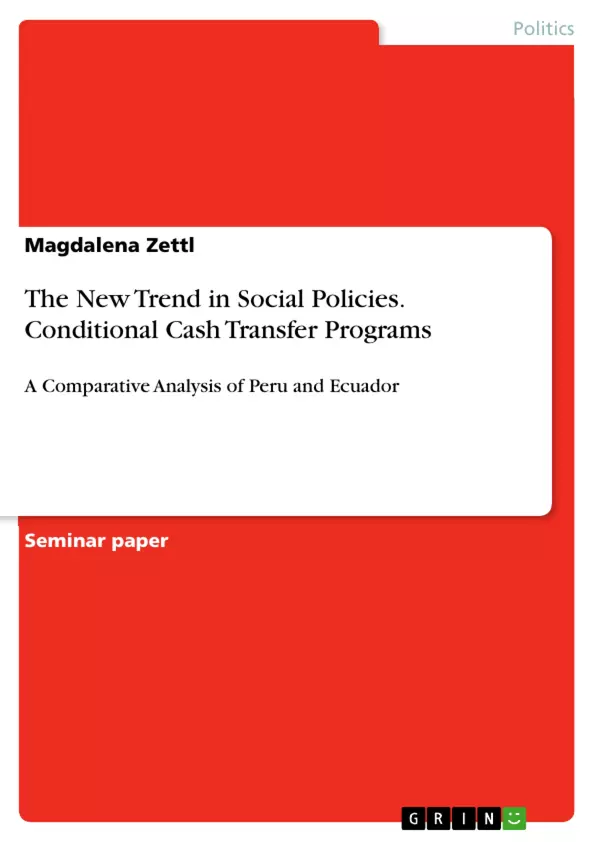During the last decade, Conditional Cash Transfer programs have become indispensable to social policies of Latin American countries. Between 1990 and 2011 seventeen countries in Central and South America started to provide financial support to poor families, based on the condition that certain health and education requirements are fulfilled. Although Conditional Cash Transfer programs of different countries are usually similar in design and outcome, each of them has its peculiarities. This paper conducts a comparative analysis of Conditional Cash Transfer programs in Peru, named Juntos, and Ecuador, named Bono de Desarrollo Humano. The aim of this paper is two-folded. By taking into account the political regime, historical legacy of social provision, current social policies as well as structural conditions of each country, this paper provides an explanation of similarities and differences of the design and outcome of Juntos in Peru and Bono de Desarrollo Humano in Ecuador. Additional to that, the paper uses this analysis to demonstrate that Conditional Cash Transfer programs alone cannot be made accountable for a reduction in poverty rates and more balanced figures of inequality.
Inhaltsverzeichnis (Table of Contents)
- Introduction
- Justification of case selection
- Comparing CCTs: Juntos, Peru and Bono de Desarollo Humano, Ecuador
- Targeting methods
- Benefit scheme
- Conditionality
- Program's administration
- Outcome on poverty, health and education
- Explaining the differences
- Political regime
- Historical legacy of social provision and current social policies
- Structural factors: economic conditions and supply side
- Conclusion
Zielsetzung und Themenschwerpunkte (Objectives and Key Themes)
This paper examines the effectiveness of Conditional Cash Transfer (CCT) programs in reducing poverty and inequality in Latin America, using Peru and Ecuador as case studies. It compares the design and outcomes of the Juntos program in Peru and the Bono de Desarrollo Humano (BDH) in Ecuador, taking into account political, historical, social, and economic factors.
- The impact of CCT programs on poverty reduction and inequality balancing.
- The influence of political regime on the design and implementation of CCT programs.
- The role of historical legacy and current social policies in shaping CCT program effectiveness.
- The interplay between economic conditions and supply-side factors on the success of CCT programs.
- The importance of comprehensive social policy strategies that go beyond CCTs.
Zusammenfassung der Kapitel (Chapter Summaries)
- The introduction outlines the emergence of CCT programs as a crucial tool for poverty reduction and inequality balancing, highlighting their dual objectives of short-term poverty alleviation and long-term human capital development.
- The justification of case selection explains why Peru and Ecuador are chosen for the comparative analysis due to their significant similarities and differences in political regimes, social policies, and CCT program designs.
- This chapter provides a detailed comparative analysis of the Juntos program in Peru and the Bono de Desarrollo Humano (BDH) in Ecuador. It examines their targeting methods, benefit schemes, conditionality requirements, program administration, and outcomes on poverty, health, and education.
- This chapter explores the key factors that contribute to the differences between Juntos and BDH. It investigates the influence of political regimes, historical legacies, current social policies, economic conditions, and supply-side constraints on CCT program effectiveness.
Schlüsselwörter (Keywords)
This paper focuses on conditional cash transfer programs, poverty reduction, inequality balancing, social policy, political regime, historical legacy, economic conditions, supply-side factors, Peru, Ecuador, Juntos, Bono de Desarrollo Humano, Latin America.
- Quote paper
- Magdalena Zettl (Author), 2013, The New Trend in Social Policies. Conditional Cash Transfer Programs, Munich, GRIN Verlag, https://www.grin.com/document/264165



